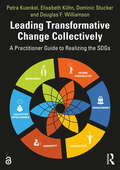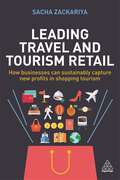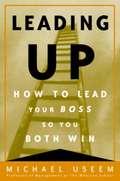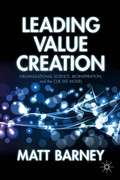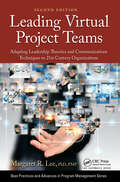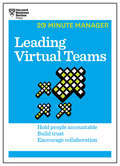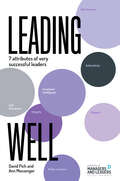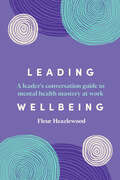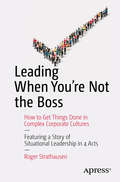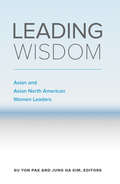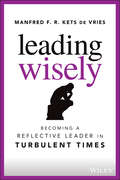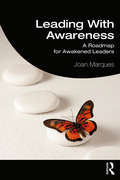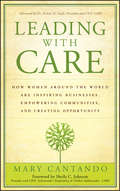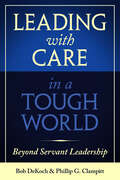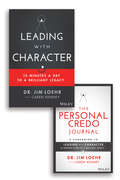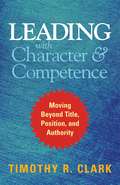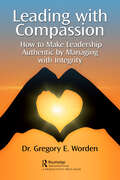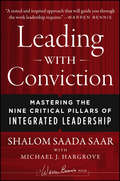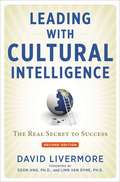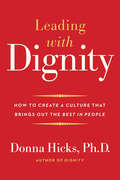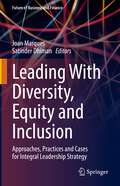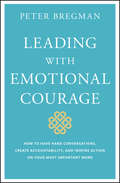- Table View
- List View
Leading Transformative Change Collectively: A Practitioner Guide to Realizing the SDGs
by Petra Kuenkel Dominic Stucker Elisabeth Kuhn Douglas F. WilliamsonThis book directly helps decision-makers and change agents in companies, NGOs, and government bodies become more proficient in transformative, collaborative change in realizing the SDGs. This practitioner’s handbook translates a systemic – and enlivening – approach to collaboration into day-to-day work and management. It connects the emerging practice of multi-stakeholder collaboration to easily understandable models, tools, and cases. Numerous, concrete cases not only bring this methodology to life, but also help identify the challenges and avoid common mistakes. The book can be used as a guide to apply a breakthrough approach for navigating the complexity of stakeholder systems, designing results-oriented process architectures, ensuring the success of cross-sector change initiatives, and enlivening collaboration ecosystems for SDG implementation. It is designed to enhance high quality stakeholder engagement, dialogue, and collaboration. A must-read, the book sets a new standard for the collaborative implementation of Agenda 2030 and is a foundational guide for leading sustainability transformations collectively to achieve climate change mitigation, social integration, equitable value chains, and broad sustainability challenges.
Leading Travel and Tourism Retail: How Businesses Can Sustainably Capture New Profits in Shopping Tourism
by Sacha Alexander ZackariyaDeepen your understanding of how to adapt to international travellers' different needs and backgrounds. Harness the burgeoning levels of tourism and learn everything you need to engage travellers with your business and spending money.The modern traveller is complex, even more so in a post-pandemic world. International consumers are in search of memorable experiences that make them feel special and, ideally, share those experiences with others and bring those feelings home with them. While wanting to be more adventurous, they also want to make their trip safe and special while minimizing their impact on the environment.Leading Travel and Tourism Retail is an invaluable guide for any professional involved in the world of retail, including consumer brands, retailers, hospitality, landlords, politicians, airports, transportation and technology groups.Engaging and accessible, this book covers everything from assessing the competitive market situation to product adaptation, ESG, human talent management, accessing funding, political considerations, and the role of technology and data. It offers a unique glimpse behind the inner workings of some of the best-known brands in the world across airports, shopping malls, and city centre locations.Delivering invaluable insight through fascinating interviews from high-profile leaders, including the President of LVMH Retail Asia, the CEO of Harrods, the President of CHANEL Perfumes & Cosmetics worldwide, this is a must-have book for those who want to drive profits.LIST OF INTERVIEWS Sir Tony Blair, former British Prime Minister, UK Pierre-Hugues Schmit, Chief Commercial & Operations Officer at Vinci Airports Group, France Ravi Thakran, Group Chairman of LVMH Asia, Singapore Michael Ward, Managing Director of Harrods, UK Jacques Stern, CEO of Global Blue, Switzerland Vasiliki Petrou, CEO of Unilever Prestige, UK Andrea d'Avack, President of the CHANEL Foundation, France Pallak Seth, CEO of PDS Apparel Manufacturing, India Louis de Bourgoing, International Chairman of WHSmith, UK Jose-Antonio Lasanta, CEO of Prosegur Cash, Spain Dan Cockerell, former Vice President of Disney's Magic Kingdom, USA Tine Arentsen Willumsen, CEO of Above & Beyond Group, Founder of The Diversity Council, Denmark Paul Samuels, Executive Vice President of AEG Entertainment Group, UK Hugo Brady, Vice President of AEG Entertainment Group, UK Malik Fernando, Director of Dilmah Tea, MJF Hotels and Holdings, Sri Lanka Jonathan Chippindale, CEO of Holition Technologies, UK Ben Zifkin, President of Hubba, Canada Desirée Bollier, Chair and Chief Merchant of Value Retail, UK Stewart Wingate, CEO of London Gatwick Airport, UK Craig Robins, Founder and Owner of Miami Design District Development, USA Taylor Safford, President and CEO of Pier 39, San Francisco, USA Frances O'Grady, Secretary General of the Trades Union Congress, UK Christine Comaford, business and leadership coach Baroness Nicky Morgan former Secretary of State for Digital, Culture, Media, and Sport, UK Professor Ian Woodward at INSEAD, Singapore Professor Steve Jarding, Harvard University, USA Lesley Batchelor OBE, Director General of The Institute for Export & International Trade, UK Jason Holt, Chair of the Apprenticeship Ambassador Network, Chairman of Holts Group, UK Julia Simpson, President & CEO of World Travel & Tourism Council (WTTC)
Leading The UK Vaccine Task Force
by Amy C. Edmondson Claudia PienicaThis case describes the first six months of the UK Vaccine Taskforce, under the leadership of Kate Bingham. With a career spent in the private sector as a biotech investor, Bingham's appointment within the government was considered unusual. The overarching brief given to her by the UK Prime Minister was simple: "Stop people from dying." At that time, however, no vaccine for human coronaviruses had ever been successfully developed, and the average time to take any new vaccine to market was over ten years. Furthermore, the UK had a relatively weak market position. Bingham assembled a senior leadership team of private sector experts and civil servants with the skills required to think about how to make vaccines, test them, deliver them, and build long-term resiliency into the system. Beyond building a diversified portfolio of vaccine candidates, the team took a commercial approach and aimed to make the UK the best global client possible. While there were some frictions due to the unusual setup of the taskforce, the team's work was an unequivocal success. The UK became the first country to approve and administer a COVID-19 vaccine outside of a clinical trial context, and had placed its bets on safe and effective vaccines.
Leading Up: How to Lead Your Boss So You Both Win
by Michael UseemEight true stories show that Leaders today aren't just bosses, they're self-starters who take charge even when they haven't been given a charge. Upward leaders get results by helping their superiors lead. They make sure that good ideas don't die on the vine because a boss's understanding doesn't reach down deep enough into the organization. Upward leadership assures that advice arrives from all points on the corporate compass, not just from the top down.
Leading Value Creation
by Matt BarneyLeading Value Creation fills the void between specialist-devised solutions and practicing leaders as the first book to take organizational science and place it into one coherent and useful model.
Leading Virtual Project Teams: Adapting Leadership Theories and Communications Techniques to 21st Century Organizations (Best Practices in Portfolio, Program, and Project Management #5)
by Margaret R. LeeThe second decade of the 21st century has brought unprecedented challenges to traditional workplaces. The global pandemic has forced the advance of working from home and telework. Individuals with little or no background or training in e-leadership, virtual project management, or virtual team management suddenly found themselves in the environment of virtual work. Leading Virtual Project Teams, Second Edition addresses the challenges that today’s virtual project management environment poses to traditional methods of leadership and communication. Leadership for successful virtual team management is different from that for traditional, collocated project team management. Explaining appropriate e-leadership styles for virtual project teams and the transition toward new leadership styles, the book is filled with communication techniques for leading virtual project teams. It helps project managers develop e-leadership competencies needed to successfully deliver projects in today’s organizations. The second edition also examines: Virtual meeting techniques Inclusive language Managing virtual relationships Why virtual work is now more important The work-at-home environment By recognizing how virtual teams are different from traditional teams, those managing virtual projects may be able to offer benefits to their organization by providing positive, successful leadership and exceptional communications, resulting in better project deliverables and products. This book provides an approach that explores all facets of e-leadership—from how traditional leadership theories and models can be applied by 21st century leaders to providing methods by which the virtual project manager can enhance virtual project communications to meet the needs of our modern global business world. It features project management checklists and templates and includes business cases, best practices, and tools and techniques for virtual project management communications.
Leading Virtual Teams (HBR 20-Minute Manager Series)
by Harvard Business ReviewLeading any team involves managing people, technical oversight, and project administration, but leaders of virtual teams perform these functions from afar. Leading Virtual Teams walks you through the basics of: Connecting your people to each other-and to the team's mission Surmounting language, distance, and technology barriers Identifying and using the right communication channelsDon't have much time? Get up to speed fast on the most essential business skills with HBR's 20-Minute Manager series. Whether you need a crash course or a brief refresher, each book in the series is a concise, practical primer that will help you brush up on a key management topic. Advice you can quickly read and apply, for ambitious professionals and aspiring executives-from the most trusted source in business. Also available as an ebook.
Leading Well: 7 attributes of very successful leaders
by David Pich Ann MessengerLeading Well is about the inspiration of leadership. It focuses squarely on the personal attributes that can transform managers into leaders and good leaders into great leaders.For this - the second book in its Leadership Series - the Institute of Managers and Leaders asked its membership of more than 10,000 which were the most important personal attributes for leadership success. The top 7 attributes selected are explored in detail in this book.Respect, integrity, emotional intelligence, ability to inspire, authenticity, self-awareness and decisiveness lie at the very heart of the ability for a leader to lead well. These attributes are presented in each of the 7 chapters and each is supported by case studies, practical advice, real-life examples, strategies for improvement and interviews with some of today's top leaders. The result is a book that is useful, practical and inspiring. Leading Well isn't about leadership theory; it's about the practice of leadership. It's about leaders rolling up their sleeves and doing things differently to have an impact.
Leading Wellbeing: A Leader's Guide to Mental Health Conversations at Work
by Fleur HeazlewoodLeaders have the responsibility to provide a psychologically safe and well work environment for their teams. With levels of stress and burnout rising, and one in five people experiencing mental illness, mental health conversation skills are no longer a nice-to-have. Mental health conversation competence is a necessary part of our leadership toolkit.Our leaders also juggle the daily pressure of competing priorities, urgent deadlines and overwhelming workloads while worrying about their team' s wellbeing, and are at risk of developing chronic stress and burnout themselves.Many leaders feel ill-equipped, lacking the skills and training to have the difficult and supportive mental health conversations that are needed to support the wellbeing of their people. Leading Wellbeing addresses the key concerns for leaders and presents a clear framework to follow for recognising the signs someone is struggling, providing psychological safety, what to say, what support is appropriate and how to balance both care and performance needs.The Mental Health Mastery approach improves leader confidence, capability and capacity in having the necessary, difficult conversations at work.
Leading When You're Not the Boss
by Roger StrathausenAnswer the questions that arise when managers and workers need to adjust to unfamiliar leadership roles and rules in flattened organizational forms. Leading When You''re Not the Boss provides a conceptual framework that you can apply when assessing your own organizations and work. The book discusses the underlying ideas necessary for a shift from a culture of hierarchies to one of relationships and the establishment of intrapreneurial and holistic work environments. This book supports the trend in many corporations toward flattening parts of their traditional top-down hierarchical management systems into more egalitarian, democratized, and distributed organizational forms. It analyzes the weaknesses of "management" culture at a time of ever more rapid change and complexity in the business world and illustrates how flattened organizational units increase agility, innovation, and efficacy. Moreover, it discusses how individuals can exercise effective leadership despite lacking the command-and-control authority of conventional bosses and ways for organizations to cultivate effective "post-management" cultures. Especially in the technology sector, large projects have become too complex to be mastered by any single leader. Drawing on his experience as a senior manager and executive consultant for a number of Fortune Global 500 companies, Roger Strathausen analyzes the situations and benefits that motivate companies to adopt flattened organizational forms. He shows that empowering a multi-talented group to manage itself by horizontal cooperation can deliver products with more speed, efficiency, innovation, and nimbleness than a solo boss could, while yielding higher employee productivity and retention rates. With an entertaining mix of real-world examples and an episodic HBR-style fictitious case study, the author illustrates throughout the book how his leadership lessons can be serviceable only when intelligently tailored to the dynamic complexities of specific situations, including the personalities and competencies of the people involved. What you''ll learn How traditional hierarchical structures inhibit agile, creative responses to the complexities of today''s business world How to tailor the techniques of shared leadership to specific business situations rather than treating them as iron rules How to flourish in nonhierarchical and ambiguously-hierarchical organizational contexts that encourage individual initiative for the joint benefit of the enterprise and personal professional growth How success and fulfillment at work are enhanced by organizational forms in which participants assess the situational relevance of their respective talents and actively apply them to group objectives in lateral cooperation with peers, as opposed to passively receiving orders from appointed bosses Who this book is for The primary readerships for this book are business leaders and managers at all levels in corporations and non-managerial professionals who work in self-directed teams. The secondary readerships are practitioners, consultants, and academics interested in the topics of human resources, organizational design, and the future of work. Table of Contents Change, As Planned and As Happens: A Plea for Human Values Leader, Know Thyself Management Unplugged: Modulating to a Post-Management Key Alpha Dogs Let Talent Lead! Fostering Situational Leadership within Self-Organizing Teams Lateral Leadership Guiding Lost Giants: A Post-Management Strategy for Adapting Jobs to Talents Why Are We Here? Conclusion
Leading Wisdom: Asian And Asian North American Women Leaders
by Su Yon Pak Jung Ha KimDiscussions about leadership, even those centered on women, often overlook contributions made by Asian and Asian North American women. Now, Su Yon Pak and Jung Ha Kim share stories of Asian and Asian North American women who found their ways, sometimes circuitously, sometimes unexpectedly, into leadership roles. <P><P>Divided into three sections—“Remembering Wisdom,” Unsettling Wisdom,” and “Inciting Wisdom”—the book presents narratives of leadership experiences in the fields of social activism, parish ministry, teaching, U.S. Army chaplaincy, religious history, Christian denominational work, theology, nonprofit organization, theological social ethics, clinical spiritual care education in healthcare systems, and community organizing. <P><P>Leading Wisdom challenges conventional understanding through its creative reimagining of what it means to lead.
Leading Wisely: Becoming a Reflective Leader in Turbulent Times
by Manfred F. Kets de VriesDiscover true leadership with this actionable guide from a world renowned leadership expert, psychoanalyst, and executive coach In Leading Wisely: Becoming a Reflective Leader in Turbulent Times, renowned leadership expert, psychoanalyst and executive coach Manfred Kets De Vries delivers an insightful and unique exploration of what it means to lead with wisdom. The book demonstrates that exclusive reliance on knowledge, data, and information yields a superficial leadership style lacking in depth and discernment. What's more important in the wisdom equation is possessing humility, judgment, empathy, compassion, and night vision. With eleven chapters full of anecdotes and tales from a variety of spiritual and cultural traditions that enrich and lend a deeper significance to the choices we make as leaders and members of organizations, Leading Wisely provides readers with: A thorough exploration of dealing with negative—but entirely natural motivations, like envy and greed An emphasis on the Golden Rule—treating others as we like to be treated ourselves An opportunity to be courageous—to consciously and intentionally pick our battles, saving energy for what really matters Lessons on how to listen intently and actively, truly hearing what our colleagues, friends, family, and followers are saying before reacting Finding happiness within ourselves Leading Wisely: Becoming a Reflective Leader in Turbulent Times is a startlingly incisive book, filled with messages that make the book required reading for anyone in a position of leadership or power. It also belongs in the libraries of well-being and health practitioners who frequently deal with businesspeople as clients or patients.
Leading With Awareness: A Roadmap for Awakened Leaders
by Joan MarquesPresenting the essentials of awakened leadership through 50 contemplative branches, this text is a revolutionary yet sensible leadership manual that takes the reader from self-reflection to interaction, touching on internal and external factors that influence business decision-making. This book is designed to expand awareness within those who lead at present or those who aspire to lead. One can only lead others responsibly having understood how to lead the self, becoming an “awakened leader.” Awakened leaders stay true to their values but are very much aware that life and business are continuous processes of growth and change—an awareness more critical than ever in today’s VUCA world. Awakened leaders recognize that these constant changes are calls to regular reflection, enabling greater empathy, understanding, and ultimately, improved decision-making. Postgraduate students and practicing leaders in the workplace will value this book, which tells them in a straightforward way how to undertake no-nonsense action with a compassionate and visionary foundation.
Leading with Care
by Mary CantandoIn partnership with international relief agency CARE, an inspiring look at how women around the world are developing businesses and creating opportunity.In this ground-breaking business book, management expert Mary Cantando examines the stories of women in the developing world who, with help from the non-profit organization CARE, have capitalized on personal and professional opportunities, contributed to their communities, influenced their physical environment, and overcome discrimination on the road to establishing self-sufficiency and building strong lives and strong businesses Structured around these five principles CARE's mission statement, Leading with Care expertly bridges inspiring stories of human endeavor with straight-up business lessons that all of us can apply to our work and organizations. Featuring interviews with top female executives at American companies who devote their own time and resources to CARE, we see just how much we can learn when it comes to growth, opportunity, and community. Each section ends with a discussion and specific questions that will help you integrate the lessons in your own life.In an ever-shifting world, CARE's message is timeless. Its practical approach to building businesses and self-sufficiency, in any economy, in any nation, gives us all hope and the power to create our own secure futures.
Leading with Care in a Tough World: Beyond Servant Leadership
by Phillip G. Clampitt Bob DeKochA new book from the authors of the highly praised Transforming Leaders into Progress Makers, Leading with Care breaks new ground in the exploration of servant leadership. Bob DeKoch and Phil Clampitt, long-time collaborators, draw on their years of innovative practice and research to describe with vivid, real-world experiences, how leading with care enriches people and transforms organizations in our challenging times. DeKoch, with over 40 years of diverse executive leadership experience, which included 20 years leading The Boldt Company, a $1 billion construction services and real estate development company, has developed novel insights into leadership thinking and practice. Clampitt, an endowed, award-winning communication and information science professor at University of Wisconsin-Green Bay, has over 40 years of experience in university teaching, ground-breaking research, and business consulting. His lifelong passion is to explore the dynamic relationship between leadership, communication, and big ideas. Gallup recently reported that only 15% of employees in the United States are truly engaged in their workplace. Yet nearly 70% of employees say they would work harder if they felt more appreciated. Over 90% of employees surveyed believed their leadership &“lacked communication skills to lead.&” The gloomy stories behind sobering statistics reveal employees&’ disappointment with current leadership approaches. Leaders can do better. That&’s why the authors sought to go beyond the laudable sentiments of the &“servant leadership&” movement by envisioning, creating, and testing a new leadership platform based on a set of guiding beliefs and actual day-to-day practices. The authors&’ unique perspective transforms traditional practices, like employee coaching and collaboration, into dynamic self-actualizing workplaces. How? By sharing how caring leaders adroitly blend visible and subtle practices to realize the aspirational benefits of coaching and collaboration. The authors use a similar approach to share insights about less frequently discussed leadership issues such as how to build an empowering network of relationships and transform pushback into progress. Anyone who wishes to craft their own distinctive, compelling, and empowering leadership style that unleashes the latent energy of people and their organizations will discover a robust and enriching framework for doing so in Leading with Care in a Tough World. &“This book offers a simple yet powerful promise: caring leaders can produce extraordinary outcomes. With extensive research and sparkling details, DeKoch and Clampitt reveal how leaders at all levels can enlist our basic humanity to bring out the best in their teams.&” --Daniel H. Pink, #1 New York Times bestselling author of The Power of Regret, When, and Drive &“Leading with Care in a Tough World is a masterful book!!! It is pragmatic, thought-provoking, and exceptionally well-written. Effective leadership today requires you to grapple with a broad range of variables. DeKoch and Clampitt provide a framework, reinforced with real-world examples and self-assessment tools, that will help you turn ideas into effective action. If you&’re a leader, or aspiring to become one, I strongly recommend this book.&”--Frank Sonnenberg, Award-winning author of nine books, including Managing with a Conscience and The Path to a Meaningful Life "Unlock the keys to successful leadership in Leading with Care in a Tough World. Filled with inspiring stories, practical advice and years of tried-and-true methods, DeKoch and Clampitt will teach you how to be the leader of the future. An excellent read!"--Dr. Marshall Goldsmith is the Thinkers50 #1 Executive Coach and New York Times bestselling author of Triggers, Mojo, and What Got You Here Won&’t
Leading with Character: 10 Minutes a Day to a Brilliant Legacy Set
by James E. LoehrFrom leadership expert Dr. Jim Loehr, strengthen your moral and ethical character for outstanding leadership results with this must-have set. Leading with Character: 10 Minutes a Day to a Brilliant Legacy At the end of your life, how are you likely to be remembered? Chances are that people won’t be praising your money, power, and status. Instead, the people you’ve impacted will remember you for your compassion and personal strength—in short, your character. Unfortunately, many leaders are unaware of their character shortcomings and blind spots that hold so many of us back from building the lasting legacy we are capable of. With the right motivation, you can begin to strengthen your character and become a moral and ethical leader capable of creating lasting change. In Leading with Character: 10 Minutes a Day to a Brilliant Legacy, Dr. Jim Loehr, cofounder of the Johnson & Johnson Human Performance Institute, reveals 50 character competencies that you can practice daily to transform your life and work. This book will also guide you through the process of developing a Personal Credo that will serve as your decision-making mission statement. Most leaders never take the time to identify their own core values, instead defaulting to a reflexive form of decision making. Gain an awareness of the conscious and unconscious processes that guide what you do and why you do it, and take charge of your leadership legacy. Even good leaders are vulnerable to corruption. Read Leading with Character to learn how human evolution and contemporary culture can lead us astray without our even knowing it. As we work hard to get to the top, who are we becoming along the way? If we want to become heroes whose memories will long outlast us, we need to channel our energy into creating habits that will add up to a strong and meaningful character. The Personal Credo Journal: A Companion to Leading with Character We all want to become high impact leaders with a robust ethical and moral character, but getting there is a challenge. Dr. Jim Loehr’s Leading with Character offers a succinct plan for developing your character as a leader and building a meaningful legacy through your life’s work. The Personal Credo Journal is a day-by-day workbook that will guide you through the process of identifying your core values and crafting your Personal Credo—a statement of beliefs and values that will help you align every action and decision with your deepest held ideals. With these activities and exercises, you’ll spend just a few minutes each day reflecting on meaningful and thought-provoking prompts about your life story, your personal strengths and weaknesses, and your life goals. By the end of this life-altering, 150-day challenge, you will have gained a deep self-knowledge and a clear vision of your path forward as a leader. Take charge of the legacy you’ll leave behind, build character, and learn to use your Personal Credo to transform your life.
Leading with Character and Competence: Moving Beyond Title, Position, and Authority
by Timothy R. ClarkLeading with Character and CompetenceMoving beyond Title, Position, and Authority "Leadership is an applied discipline, not a foamy concept to muse about," says three-time CEO, Oxford-trained scholar, and consultant Timothy R. Clark. "In fact, it's the most important applied discipline in the world." The success of any organization can be traced directly to leadership. And leadership can be learned. But too many books and development programs focus exclusively on skills. In reality, performance and ultimate credibility are based on a combination of character and competence. As Clark puts it, character is the core and competence the crust. He shows how greatness emerges from a powerful combination of the two, although in the end character is more important. A leader with character but no competence will be ineffective, while a leader with competence but no character is dangerous.Clark spotlights the four most important components of character and competence and offers a series of eloquent, inspiring, and actionable reflections on what's needed to build each one. Fundamentally, he sees leadership as influence--leaders influence people "to climb, stretch, and become." You need character to influence positively and competence to influence effectively. This is a book for anyone, no matter where he or she is on the organization chart. Because today employees at all levels are being asked to step up, not only can everyone be a leader, everyone has to be. Clark's insights are profound, and his passion is infectious. "Leadership" he writes, "is the most engaging, inspiring, and deeply satisfying activity known to humankind. Through leadership we have the opportunity to progress, overcome adversity, change lives, and bless the race."
Leading with Compassion: How to Make Leadership Authentic by Managing with Integrity
by Gregory E. WordenBusiness schools teach the transactional tools one needs to work in business. They teach various strategic planning and decision-making models such as SPACE or SWOT or decision trees or weighted grids. They teach about the various functions of an organization, financial ratios, and breakeven analyses. And they may even have a class on business ethics. But those tools are more about knowing where the business-case boundaries are as a risk prevention measure and do not help one to think about how they should comport themselves as a leader. This book is about helping you to become your best self and helping those around you to achieve their best. Inherently it’s about authenticity, integrity, and empathy and how these simple traits can lead to high performance. The book explores ways to make our leadership more authentic and to lead with integrity. It discusses how to mentor employees and how this can lead to higher-performing teams and more successful organizations. The book is organized around four major constructs. The first is about personal leadership. It starts with honesty and integrity. That provides the basis for an empathetic leadership style. This is one that helps to engage followers and brings them along because they want to come along for the journey, rather than feeling forced. That is the nature of the second construct: building and maintaining high-performing teams. This is then the basis for building a trusting culture. Change is all around us and that can be exhausting. Building a culture of trust is the first step toward building an agile organizational culture. That is the third construct. Finally, the last is a message of simple optimism. There are many challenges facing society today, but with thoughtful, engaging leaders there is hope that we can collectively rise to the challenge.
Leading with Conviction
by Shalom Saada Saar Michael J. HargrovePractical advice and tools to help leaders at all levels elevate their skillsWhat can truly set an organization apart? There is only one asset that offers guaranteed differentiation: leadership. Leadership is a deliberate act that requires effort but yields enormous payback. According to the renowned professor Shalom Saar and co-author Michael J. Hargrove, both internationally recognized leadership development consultants, executive coaches and speakers, leadership can be learned and improved through the nine critical competencies explored in this book. Filled with sage advice and engaging examples, as well as multiple mini-assessments, this book presents a programmatic approach to engage and grow leaders at every level and in any type of organization.Outlines the nine core competencies that define exceptional leadershipUses a proven approach to enhance leadership skills that can be applied to any organizational settingOffers a wide array of practical tools for aspiring and experienced leaders Written by Shalom Saar and Michael Hargrove, the cofounders of the Center for Leadership Development, (Saar is also a leading professor at MIT and previously Harvard, as well as other top schools globally)Leading with Conviction offers a wealth of advice to help leaders establish a compelling vision, motivate their workforce, manage change and conflict, and create benchmarks that lead to sustainable success.
Leading with Cultural Intelligence: The Real Secret to Success
by David LivermoreBusiness today is global--and success requires a new set of skills. But not to worry, whether you're negotiating with vendors in Asia, exploring potential markets in Africa, or leading a diverse team at home, you don't have to master the nuances of every culture you encounter. With Cultural Intelligence, or CQ, you can lead effectively in any context. Featuring fresh research, case studies, and statistics on the ROI of improving your CQ, this new edition of Leading with Cultural Intelligence details a powerful, four-step model for becoming more adept at managing across cultures: Drive--boost your motivation for and confidence in interacting with other cultures Knowledge--understand the relevance of differences in religion, values, norms, and languages Strategy--plan ahead for unfamiliar cultural settings, but remain flexible if actual experience differs from expectations Action--successfully adapt your behavior to each situation With Leading with Cultural Intelligence as your guide, you'll be able to thrive in any business environment--whether it's across the world or in your own backyard.
Leading with Cultural Intelligence
by Mai MouaLeading with Cultural Intelligence outlines the important concepts of cultural intelligence (CI) and the steps that must be practiced to become a culturally intelligent leader. CI is both a strategy and a tool that leaders can use to gain more confidence and proficiency when working across cultures. This book outlines the importance of understanding culture and its impact on organizations, the strategic value of cultural intelligence, and the significance of integrating and practicing cultural intelligence in everyday business life. When all these aspects are properly integrated and applied in the leadership and management process, organizations are more innovative and adaptable to respond to cultural changes.
Leading with Dignity: How to Create a Culture That Brings Out the Best in People
by Donna HicksWhat every leader needs to know about dignity and how to create a culture in which everyone thrives This landmark book from an expert in dignity studies explores the essential but under-recognized role of dignity as part of good leadership. Extending the reach of her award-winning book Dignity: Its Essential Role in Resolving Conflict, Donna Hicks now contributes a specific, practical guide to achieving a culture of dignity. Most people know very little about dignity, the author has found, and when leaders fail to respect the dignity of others, conflict and distrust ensue. She highlights three components of leading with dignity: what one must know in order to honor dignity and avoid violating it; what one must do to lead with dignity; and how one can create a culture of dignity in any organization, whether corporate, religious, governmental, healthcare, or beyond. Brimming with key research findings, real-life case studies, and workable recommendations, this book fills an important gap in our understanding of how best to be together in a conflict-ridden world.
Leading With Diversity, Equity and Inclusion: Approaches, Practices and Cases for Integral Leadership Strategy (Future of Business and Finance)
by Joan Marques Satinder DhimanThis book guides managers and leaders toward greater insight and more deliberate practices in regards to diversity, equity, and inclusion addressing leadership, operations, and the educational environments. The authors consider the qualities of awakened leadership as critical components for establishing and nurturing a diverse, equitable and inclusive work environment. The book argues that the only way destructive conflicts can be resolved on a lasting basis is through profound collaboration, which can be embedded in performance structures by questioning biases, and becoming aware of limiting mindsets and traditions, that keep parts of society subjugated. It offers a wide range of constructive approaches that lead to higher awareness, thus, better understanding and focus on stakeholders. Finally, it presents examples of diversity-engendered issues and their resolutions from around the globe.
Leading With Emotional Courage: How to Have Hard Conversations, Create Accountability, And Inspire Action On Your Most Important Work
by Peter BregmanThe Wall Street Journal bestselling author of 18 Minutes unlocks the secrets of highly successful leaders and pinpoints the missing ingredient that makes all the difference You have the opportunity to lead: to show up with confidence, connected to others, and committed to a purpose in a way that inspires others to follow. Maybe it’s in your workplace, or in your relationships, or simply in your own life. But great leadership—leadership that aligns teams, inspires action, and achieves results—is hard. And what makes it hard isn’t theoretical, it’s practical. It’s not about knowing what to say or do. It’s about whether you’re willing to experience the discomfort, risk, and uncertainty of saying or doing it. In other words, the most critical challenge of leadership is emotional courage. If you are willing to feel everything, you can do anything. Leading with Emotional Courage, based on the author’s popular blogs for Harvard Business Review, provides practical, real-world advice for building your emotional courage muscle. Each short, easy to read chapter details a distinct step in this emotional “workout,” giving you grounded advice for handling the difficult situations without sacrificing professional ground. By building the courage to say the necessary but difficult things, you become a stronger leader and leave the “should’ves” behind. Theoretically, leadership is straightforward, but how many people actually lead? The gap between theory and practice is huge. Emotional courage is what bridges that gap. It’s what sets great leaders apart from the rest. It gets results. It cuts through the distractions, the noise, and the politics to solve problems and get things done. This book is packed with actionable steps you can take to start building these skills now. Have the courage to speak up when others remain silent Be stable and grounded in the face of uncertainty Respond productively to opposition without getting distracted Weather others’ anger without shutting down or getting defensive Leading with Emotional Courage coaches you to build your emotional courage, exercise it effectively, and create an environment in which people around you take accountability to get hard things done.
